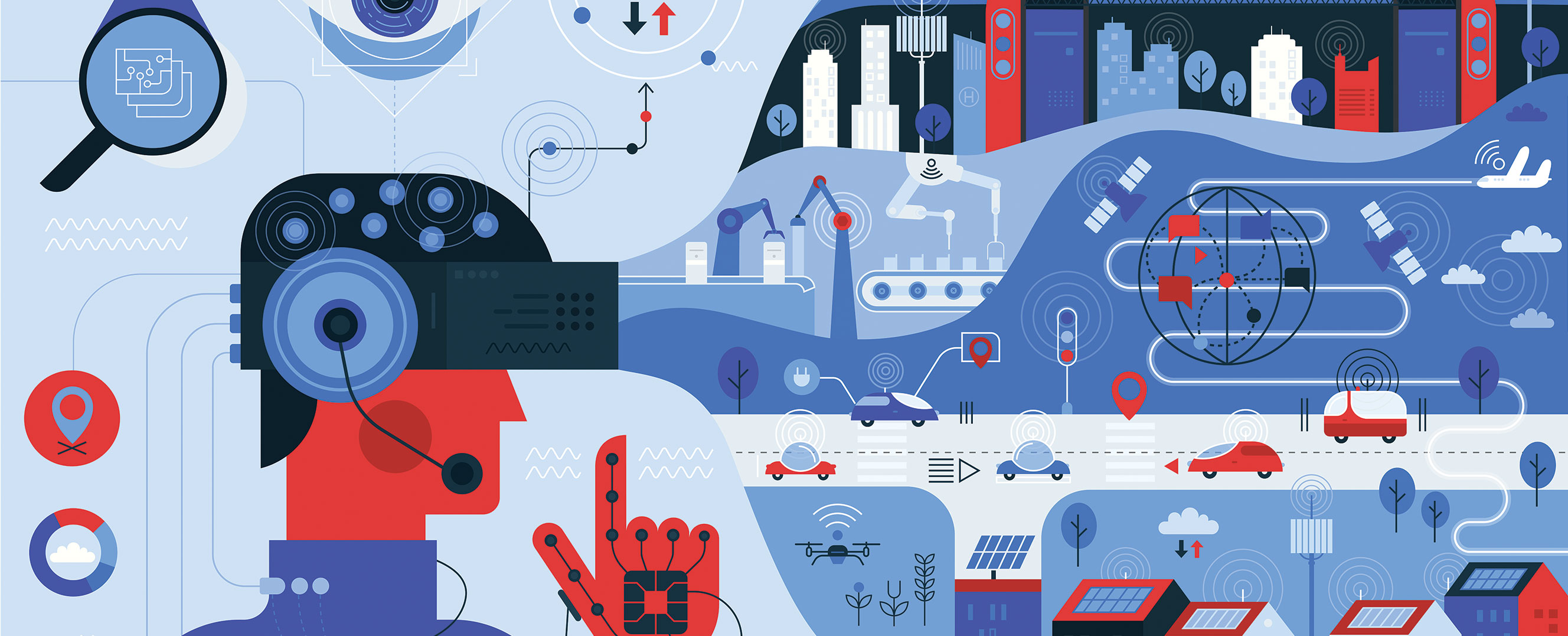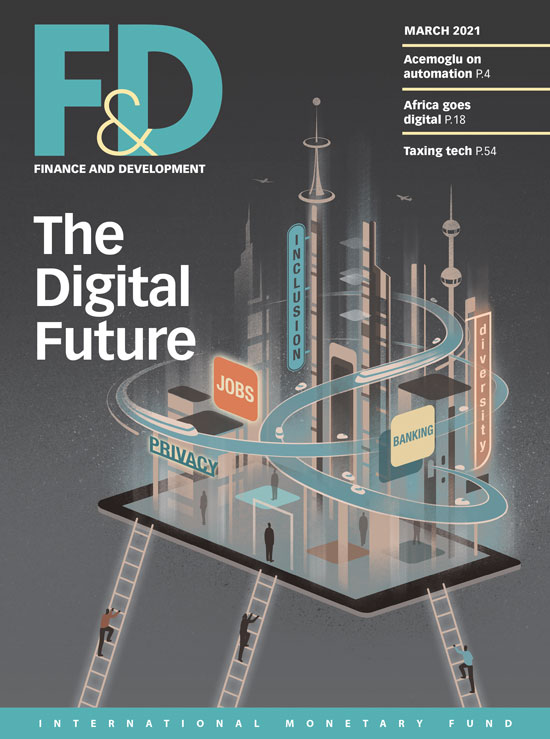The shift to a hyperconnected world presents a formidable opportunity—but also risks and challenges
Everyone has an opinion on the many ways lockdowns and technology have altered our lives and on how long these changes will last. Technology firms are betting on a permanent trend. They are rapidly adjusting to a post-COVID world where people will do more from home—buying, learning, working, and socializing—and avoid interacting with the physical world whenever possible, with so-called touchless technologies.
The 2021 Consumer Electronics Show, one of the world’s most influential tech events, recently offered a glimpse of what’s to come. Laptops are now designed for videoconferencing, equipped with multiple cameras, special lights, and software-optimized audio. N95 masks with built-in Bluetooth headsets and microphones, coupled with smart glasses with ultra-small displays, promise to keep people safely connected while on the go. The spread of germs can also be controlled at our doorsteps, with touchless doorbells that notify homeowners when visitors arrive and maybe even check their temperature!
Technological advancements are not reserved for rich countries and are not limited to high-tech gadgets, however. In lower-income countries, for example, where medical expertise is scarce or even completely absent, Big Tech firms are making open-source artificial intelligence (AI) code available for medical image analysis, which can be a game changer in health care, including for early detection of cancers. The increased need for remote health care and remote education has generated new interest in augmented reality. UNICEF and other organizations expect this technology to be an essential bridge to the digital world for people with low literacy, many of whom live in developing economies. As technology rapidly changes to enable a smarter and more equitable world, the focus is on foundational elements, including infrastructure, digital identity, and new digital risks, to accompany this transformation.
Satellite mega constellations
Take, for example, internet satellites. Could a new generation of satellite mega constellations be a game changer for the 53 percent of the developing world with no internet connectivity? Theoretically, yes—SpaceX has already launched more than 1,000 of 12,000 planned low-Earth-orbit Starlink satellites. These spacecraft are so close to the ground that they can beam internet down to every remote area in the world with unmatched quality and speed—whether it’s to a remote village in Ghana or a base on the deserted North Pole. Other companies, such as OneWeb, plan to launch 650 satellites this year alone, and Amazon’s Project Kuiper is expected to send up thousands of high-speed satellites soon. This technology could help countries leapfrog decades of infrastructure investments.
According to IMF research, a 10 percent increase in internet penetration could raise real per capita GDP growth 1 to 4 percentage points in sub-Saharan Africa. The potential is significant, given that three-quarters of the people in the region do not currently have internet access. And in every country, inequality is amplified when access to broadband connectivity is lacking.
Terrestrial internet access currently requires large multiyear infrastructure investments in cross-border networks, national internet-supporting “backbones,” and regional and “last mile” connections—expected to cost about $100 billion over the next 10 years for Africa alone. Low-Earth-orbit satellite companies promise to do it for a fraction of that cost, in the next two years, and households will need only a small antenna and a box. The satellites can even serve as the backbone for mobile networks, which could further accelerate fast internet adoption, given people’s preference for mobile access.
So what’s the catch? First, the number of satellites around the globe will grow from fewer than 3,000 today to possibly more than 20,000, which will impact ground-based astronomy. The expected cost for individuals—initially about $100 a month, plus another $500 for the hardware—is too steep for people in poorer countries and would require subsidies. Finally, if widespread connectivity becomes available much sooner than expected, policymakers must understand its impact and their role in making it valuable for their citizens.
Previously underserved people may not, for example, understand the major languages used on the internet. Without basic digital and financial skills training, people may only partially benefit from internet connectivity. Most important, with more connectivity come more digital threats, such as fraud and misuse of data. In the next two years, this new generation of high-speed internet satellites has the potential to transform the lives of billions of people. International organizations, development banks, and governments can seize this new opportunity. But regulation, digital skills programs, and changes in mindset will be necessary.
Digital identity
And then there is digital identity technology. Even before the pandemic accelerated the transition to a more connected world, digital identity was seen as one of the most significant technology trends, especially for the developing world. According to the World Bank Group, 1.1 billion people worldwide lack documentation or verifiable credentials to prove their identity. For years, countries have tried to replicate the success of India’s Aadhaar digital ID and the e-Estonia national identity system. The expected benefits include increased government transparency (regarding the budget and elections, for example), easier access to government assistance, and expanded access to basic financial services, especially for displaced or undocumented people.
Over the years, adoption has been slowed by numerous challenges, ranging from ineffective national coordination to limited digital literacy. Cybersecurity issues, data privacy concerns, and mistrust of technologies provided by government have also delayed the deployment of digital ID in many countries. These unresolved challenges have often relegated digital identity programs to the back burner.
But the COVID-19 pandemic has forced governments to rapidly overcome or sidestep these issues to deliver urgently needed financial assistance and other forms of support to the most vulnerable citizens. The time is ripe: the benefits of deploying a national digital ID, including its potential for reliable databases with socioeconomic indicators, now outweigh some of the concerns.
The underlying technologies are now quite mature. For example, security and encryption algorithms, such as two-factor authentication and asymmetric encryption, improve the integrity and privacy of data. Artificial intelligence, machine learning, and biometric sensors built into mobile devices can significantly reduce fraud. They can also simplify users’ experience by scanning their fingerprints, face, or voice. Moreover, digital ID open-source software, open application-programming-interface (API)-based solutions, and international standards have recently emerged, reducing the implementation costs of national digital ID programs.
Technology providers are already one step ahead, and a new generation of ID solutions is rapidly emerging. Early tests of blockchain-based identities are gaining momentum in several countries, including in Estonia. This potentially groundbreaking technology could shift the control and ownership of data from governments to citizens while preserving governments’ authority to issue and validate identity and related services.
But the risks and potential for misuse of digital identity remain real and require the careful, continuous attention of policymakers and regulators. The pandemic certainly has highlighted the benefits of digital ID, but it has also exposed the dangers to privacy when combined with other technologies, such as tracing applications. Regardless of which technology is used, successful digital ID systems must be secure, inclusive, and interoperable to deliver their transformative impact for the billions of people without IDs.
Managing digital risks
The pandemic has leapfrogged digital adoption worldwide, some say by five years. The flip side, as illustrated above, is that digital risks have accelerated at the same rate. Companies are now more exposed to online threats due to the increased use of personal computers to access corporate systems. Contact tracing applications have raised tensions between data privacy and public health policy goals, challenging regulators and policymakers. Hackers have exploited fears and anxiety about the virus to lure people into phishing schemes and trick them into downloading malware. Even more disconcerting are threats of ransomware attacks against hospitals and of intellectual property theft against vaccine companies in the midst of the pandemic.
This is not new: awareness of cyber risks was on the rise even before the pandemic. Geopolitical tensions and new cyber-offensive capabilities have inspired both nation-states and nonstate actors, blurring the lines between spies and malicious hackers. The World Economic Forum recognized the threat even in 2019, adding cybersecurity to the top of the global risk landscape, right next to climate change.
But the scale and threat landscape have changed rapidly. For countries seeking to embrace the promise of digital transformation, cybercrime is only one of the many digital risks to manage. The role of technology in amplifying misinformation is clear to everyone—and not only when it comes to the United States. Experts fear that deepfakes—deceptive videos produced by artificial intelligence and made to look like the real thing—may fuel political tension by spreading disinformation that is hard to debunk. Fears about AI are rooted in very real concerns. These include faster-than-expected automation of certain jobs, amplification of gender and racial biases, and the so-called black box problem—when AI reaches conclusions that even its developers can’t explain.
The shift to a hyperconnected world is a formidable opportunity for billions of citizens to have better access to education, health, employment, and financial services. This decade will continue to witness faster digitalization, more complex digital questions, and ever changing digital risks. The question is: Can governments become more agile, and can they rapidly adopt a more comprehensive approach to risk regulation and digital strategy to reap the benefits of this acceleration while limiting the risks?
Opinions expressed in articles and other materials are those of the authors; they do not necessarily represent the views of the IMF and its Executive Board, or IMF policy.









